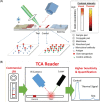State of diagnosing infectious pathogens using colloidal nanomaterials
- PMID: 28898761
- PMCID: PMC7124370
- DOI: 10.1016/j.biomaterials.2017.08.013
State of diagnosing infectious pathogens using colloidal nanomaterials
Abstract
Infectious diseases are a major global threat that accounts for one of the leading causes of global mortality and morbidity. Prompt diagnosis is a crucial first step in the management of infectious threats, which aims to quarantine infected patients to avoid contacts with healthy individuals and deliver effective treatments prior to further spread of diseases. This review article discusses current advances of diagnostic systems using colloidal nanomaterials (e.g., gold nanoparticles, quantum dots, magnetic nanoparticles) for identifying and differentiating infectious pathogens. The challenges involved in the clinical translation of these emerging nanotechnology based diagnostic devices will also be discussed.
Keywords: Clinical translation; Diagnostics; Nanomaterials; Nanotechnology; Point of care.
Copyright © 2017 Elsevier Ltd. All rights reserved.
Figures












References
-
- Taylor L.H., Latham S.M., Woolhouse M.E.J., Lathamt S.M., Bush E. Risk factors Hum. Dis. Emergence. 2013;356:983–989.
Publication types
MeSH terms
Substances
LinkOut - more resources
Full Text Sources
Other Literature Sources

